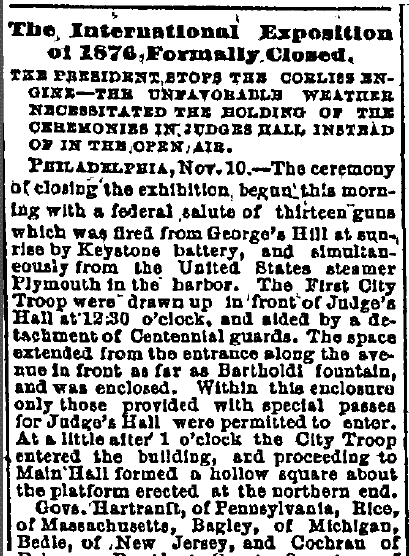Introduction: In this article, Gena Philibert-Ortega writes about the 1876 Philadelphia Centennial Exhibition that celebrated 100 years of American independence. Gena is a genealogist and author of the book “From the Family Kitchen.”
Do you remember the American Bicentennial? In 1976 Americans celebrated our shared history and our fight for freedom. Visual reminders of the early history of America were everywhere. My school picture that year had a background of an American flag, and as I stood against that background my arm rested on a faux chair that had a small eagle painted in gold. For those who were around in 1976, it is easy to date that image.
Did you have ancestors living in the United States in 1876? Just as you may have participated in bicentennial celebrations, they participated in centennial activities to celebrate 100 years of American independence. Maybe they even attended the biggest celebration of America’s freedom: the Philadelphia Centennial Exhibition, the first time an official World’s Fair was held in the U.S. From May to November 1876 in Fairmount Park, the city of Philadelphia provided Americans the opportunity to see history, experience the newest technologies and innovations, and show patriotism just 11 years after the Civil War ended.

Approximately 10 million visitors strolled the Philadelphia Centennial Exhibition’s 285 acres and saw exhibits in more than 200 buildings. The Exhibition of 1876 offered everything from historical and technological exhibits to food. Most states participated as well as over 30 nations. Patriotism was a big part of the great Centennial Exhibition but so too were the machines and exhibits that touted America’s innovation.
Many of the top American inventors of the day presented their newest creations at the Philadelphia Centennial Exhibition. This was the international event where attendees from around the world were introduced to Alexander Graham Bell’s invention he called the telephone, and Thomas Edison was there showcasing some of his new ideas. Many everyday household items that we now take for granted were either exhibited or introduced at the Exhibition including typewriters, sewing machines and even Heinz 57 Tomato Ketchup. The largest steam engine ever built, weighing a staggering 56 tons, was at the Exhibition and powered the Machinery Hall.
Even Lady Liberty was there—well, part of her arm and torch to be precise. This section of the Statue of Liberty was displayed at the Centennial Exhibition as part of a fundraising effort to raise the money needed to build a base for the permanent statue.

All good things must come to an end and so did the Centennial Exhibition. On November 10th President U.S. Grant, with a wave of his hand and the words “I declare the Centennial International Exhibition of 1876 closed,” marked the official end of the Exhibition. For ten days after that official declaration the Exhibition continued to stay open and allowed people to visit the exhibits until they were removed.

Today, all that is left of that 1876 event is Memorial Hall, the Ohio House (which now houses a café), and two smaller buildings.*
The Free Library of Philadelphia has an online exhibit, The Centennial Exhibition, where you can learn more about the fate of the buildings and machinery at the legendary Exhibition and about the event itself. Fairmount Park, the park that hosted the Exhibition, has an archival collection available to researchers by appointment.
Want to learn more about the 1876 Centennial Exhibition? The original guides to the Exhibition are available on Google Books. For a look at the history and images from the Exhibition see the “Images of America” book Philadelphia’s 1876 Centennial Exhibition by Linda P. Gross and Theresa R. Snyder (Arcadia Publishing, 2005).
If your ancestors were alive in 1876, perhaps they went to see the Centennial Exhibition themselves—about 20% of the American public did. Even if your ancestors did not actually visit the Exhibition, it was a big event during their lifetime that they most likely talked about in their homes and communities. You can peruse GenealogyBank’s historical newspaper archives to read thousands of news articles containing the original coverage on the Centennial Exhibition. GenealogyBank’s online newspaper archives are a great place to learn about your ancestors’ lives and the times they lived in—from 1690 to the present.
________________________________
*Whatever Happened to: Buildings. Centennial Exhibition Digital Collection. Free Library of Philadelphia. https://know.freelibrary.org/Record/1317992

Great article about the independence of America. That fest was totally remarkable along the time of history. That fest inspires us heading in the forward, the next race of our lives. Salutations to the people who brought the independence.
I really like reading through a post that will make men and women think.
Also, thank you for permitting me to comment!